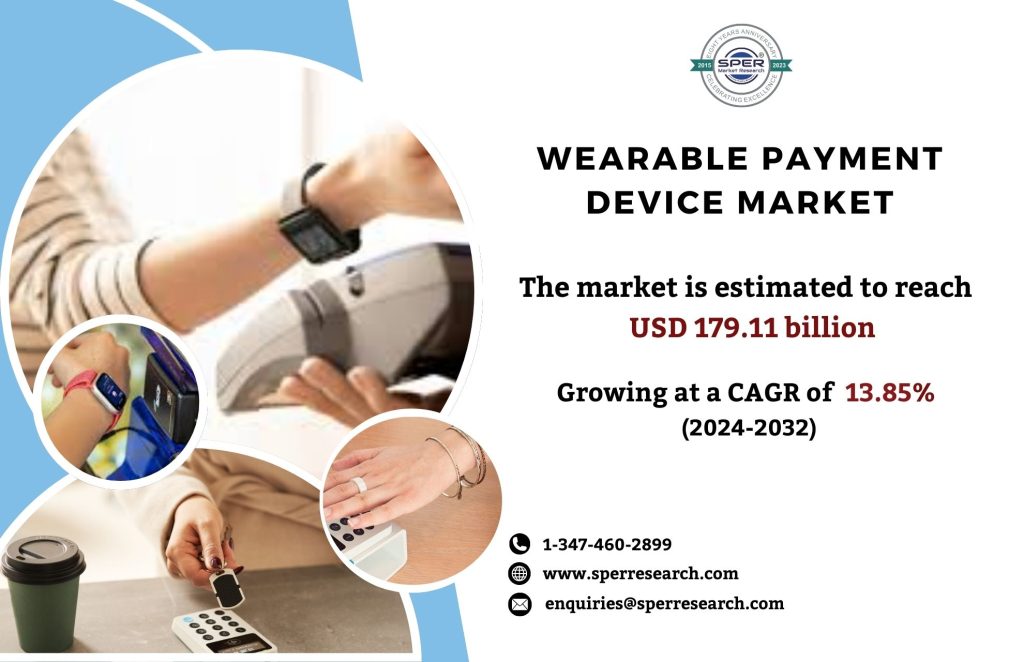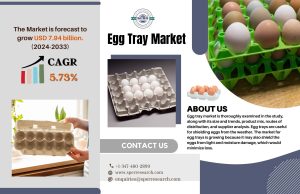Wearable payments utilize modern technology integrated into wearable devices to allow consumers to perform secure purchases of goods and services. Since it provides shops and suppliers with an increased secure and error-free payment alternative, many businesses and organizations refer to it as the “tap-and-go” payment method. Moreover, it allows executive payments by the tapping of contactless cards or devices with payment capabilities. Furthermore, contactless payments offer several advantages over conventional payment methods that’s why the wearable payment devices are widely employed in BFSI, retail, energy and utilities, and a variety of other industries.
According to SPER Market Research, ‘Wearable Payment Device Market Size- By Device, By Technology, By Sales Channel, By Application- Regional Outlook, Competitive Strategies and Segment Forecast to 2032’, states that the Global Wearable Payment Device Market is estimated to reach USD 179.11 billion by 2032 with a CAGR of 13.85%.
Wearable payment devices eliminate the need for consumers to carry about physical wallets or credit cards, speeding up and simplifying transactions. This convenience aspect is one that has a significant impact on client approval. As smartphones grow in number, wearable payment devices may effortlessly connect with them, boosting the framework for digital payments overall. Many wearable payment systems are designed to work in combination with smartphones, providing increased effectiveness and convenience. Wearable payment gadgets offer more security compared to traditional payment methods as they tend to come with built-in security features like biometric verification or PIN protection. The market for wearable technology, such as smartwatches and fitness trackers, is being pushed by the growing need for wearable payment devices.
Compatibility issues between different wearable payment systems and devices could exist. When these gadgets aren’t compatible with the preferred payment systems or methods, users might feel hesitant to accept them. Some customers might be turned off by concerns about the reliability and longevity of the batteries that power wearable payment gadgets. Issues such as a device that frequently malfunctions or needs continuous charging may have an impact on users’ satisfaction levels. The cost of wearable payment gadgets may prevent them from being adopted by some clients. Some potential customers might still think that costs are excessively high, although they have been falling over time.
Request For Free Sample Report @ https://www.sperresearch.com/report-store/wearable-payment-device-market.aspx?sample=1
Impact of COVID-19 on the Global Wearable Payment Device Market
The COVID-19 pandemic had very less effect on the market. Due to increased health concerns followed by COVID-19, there has been a surge in demand for wearable technology. The significance and use of wearable technology have been highlighted by the pandemic. Wearable technology is being adopted by users in order to accept contactless payments. Given the possibility of contamination, it has expedited the transition from cash to digital solutions via cellphones and wearable payment devices.
Wearable Payment Device Market Key Players:
Due to its high rate of technological adoption and increasing demand for contactless payment methods, North America serves a major market for wearable payment devices, having the highest share. Although the market in regions like Europe and Asia-Pacific is growing rapidly too. Major market players in this market are Apple Inc. (US), Samsung Electronics Co., Ltd. (South Korea), Fitbit Inc. (US), Garmin AB (Switzerland), Xiaomi Corporation (China), Google LLC (US), PayPal Holding Inc. (US), Barclays PLC (UK), MasterCard, VISA Inc. (US), Tappy Technologies Ltd. (US)
Global Wearable Payment Device Market Segmentation:
The SPER Market Research report seeks to give market dynamics, demand, and supply forecast for the years up to 2032. This report contains statistics on product type segment growth estimates and forecasts
By Application: Based on the Application, Global Wearable Payment Device Market is segmented as; Retail/Grocery Stores, Restaurants, Hospitals/Pharmacies, Entertainment Centers
By Device: Based on the Device, Global Wearable Payment Device Market is segmented as; Smart Watches, Fitness Tracker, Payment Wristbands, Smart Rings
By Sales Channel: Based on the Sales Channel, Global Wearable Payment Device Market is segmented as; Direct Sales, Indirect Sales
By Technology: Based on the Technology, Global Wearable Payment Device Market is segmented as; Near-field Communication Technology (NFC), Radio Frequency Identification (RFID), QR & Bar Codes
By Region: The Global Wearable Payment Device Market report covers Australia, Brazil, China, France, Germany, India, Indonesia, Japan, Russia, South Korea, the United Kingdom, and the United States.
This study also encompasses various drivers and restraining factors of this market for the forecast period. Various growth opportunities are also discussed in the report.
For More Information, refer to below link:-
Wearable Payment Device Market Revenue
Related Reports:
Follow Us –
LinkedIn | Instagram | Facebook | Twitter
Contact Us:
Sara Lopes, Business Consultant – U.S.A.
SPER Market Research
+1-347-460-2899



